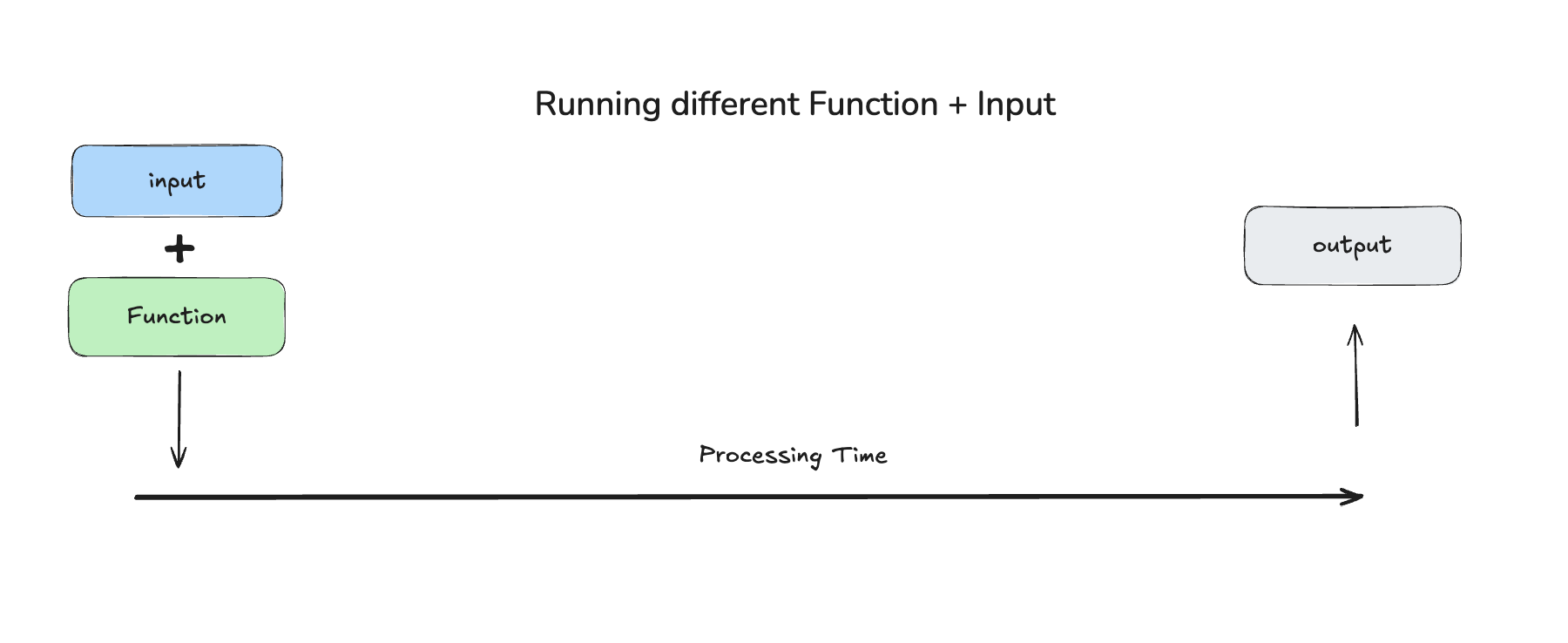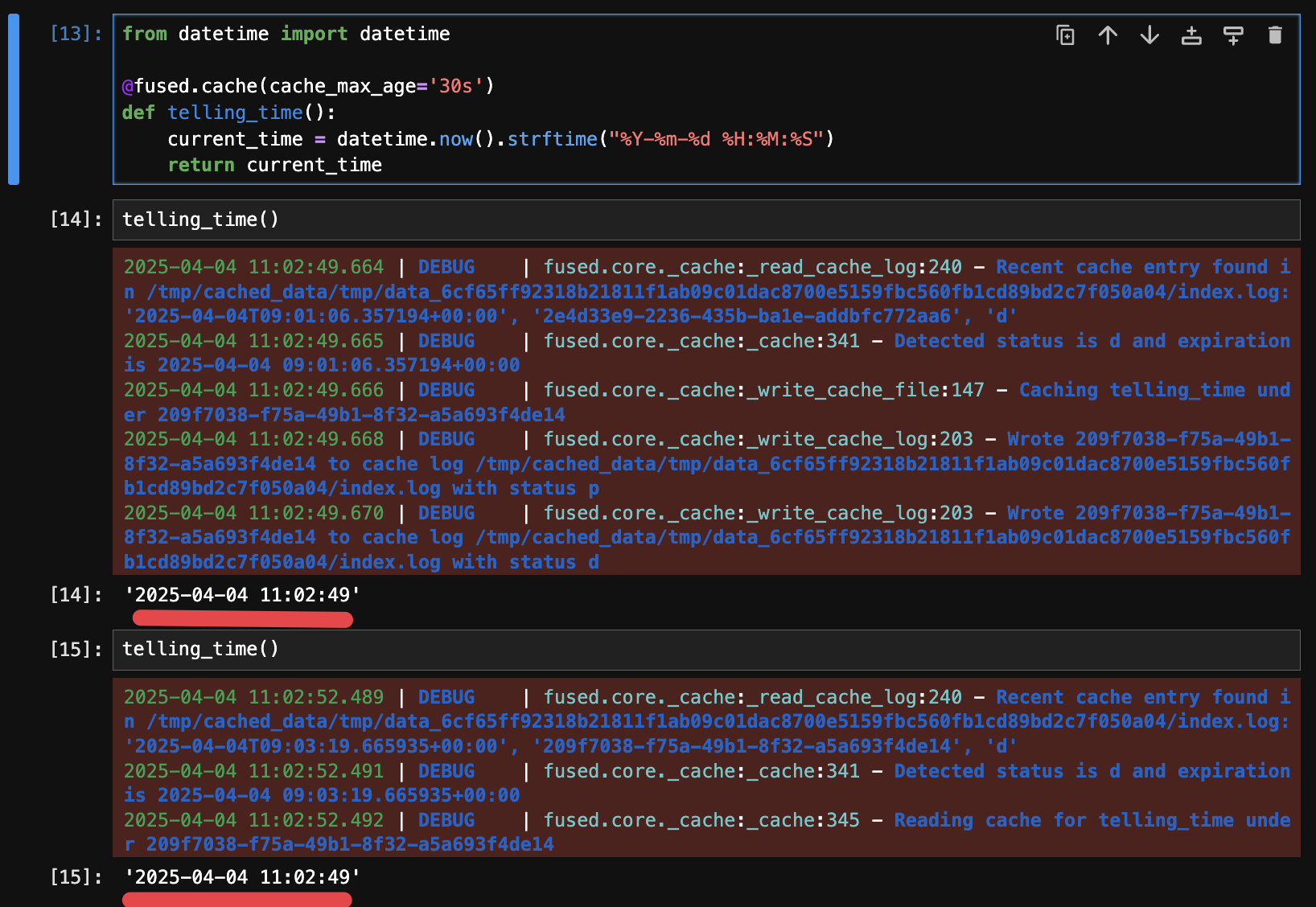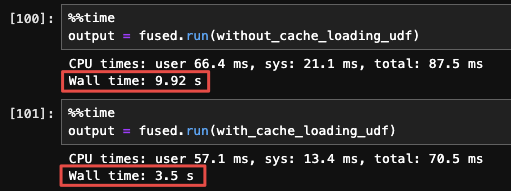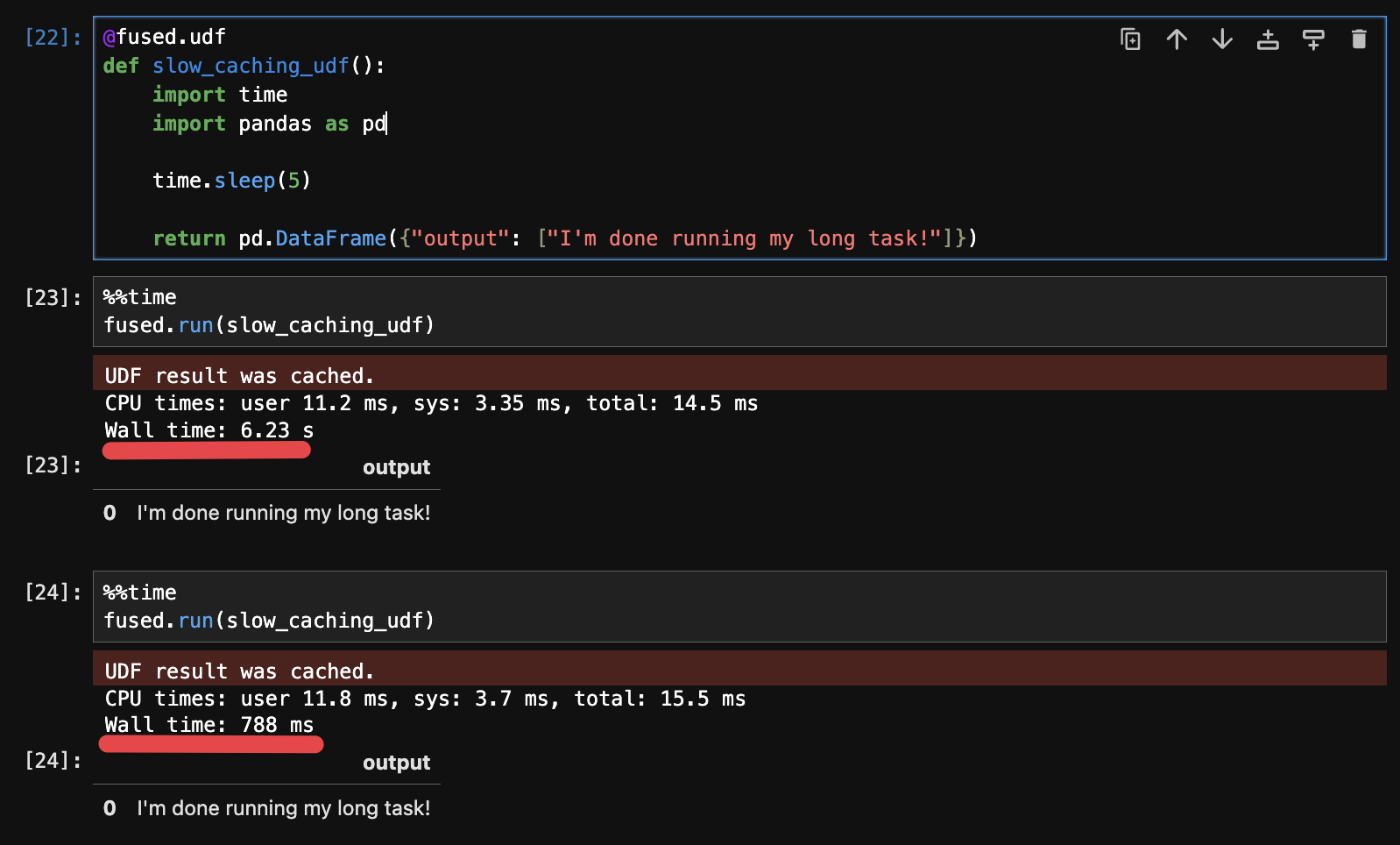Caching
This pages explains how caching makes Fused more responsive & some best practices for making the best use of it
Caching Basics
The goal of Fused is to make developing & running code faster for data scientists. This is done by using efficient file formats and making UDFs simple to run. On top of those, Fused relies heavily on caching to make recurring calls much faster.
At a high level, caching is storing the output of a function run with some input so we can directly access the result next time that function is called with the same input, rather than re-computing it to save time & processing cost.

The first run of a [Function + Input] is processed, but the next time that same combination is called, the result is retrieved much faster
As soon as either the function or the inputs change however, the output needs to be processed (as the result of this new combination has not been computed before)

Fused uses a few different types of cache, but they all work in this same manner
Caching any Python function: @fused.cache
Locally
Any Python function, either inside a UDF or even locally on your machine can be cached using the @fused.cache decorator around it:
# This works locally on your machine
import python
from datetime import datetime
@fused.cache(cache_max_age='30s')
def telling_time():
current_time = datetime.now().strftime("%Y-%m-%d %H:%M:%S")
return current_time
telling_time()

As seen in the debug logs, your cached data will be saved under /tmp/cached_data/tmp/ locally.
Similar to how this works with fused.run(), you can overwrite cache_max_age when executing your function directly:
telling_time(cache_max_age="0s") # Overwrite cache duration to be 0s, i.e. no caching
Inside a UDF
This also works inside a UDF by passing @fused.cache decorator around any function:
@fused.udf
def udf():
import pandas as pd
@fused.cache
def load_data(i):
# Do heavy processing here
return pd.DataFrame({"id": [i]})
df_first = load_data(i=1)
df_first_repeat = load_data(i=1)
df_second = load_data(i=2)
return pd.concat([df_first, df_first_repeat, df_second])
Under the hood:
- The first time Fused sees the function code and parameters, Fused runs the function and stores the return value in a cache.
- This is what happens in our example above, line 10:
load_data(i=1)
- This is what happens in our example above, line 10:
- The next time the function is called with the same parameters and code, Fused skips running the function and returns the cached value
- Example above: line 11,
df_first_repeatis the same call asdf_firstso the function is simply retrieved from cache, not computed
- Example above: line 11,
- As soon as the function or the input changes, Fused re-computes the function
- Example above: line 12 as
i=2, which is different from the previous calls
- Example above: line 12 as
Implementation Details
A function cached with @fused.cache is:
- Cached for 12h by default (can be changed with
cache_max_age) - Stored as pickle file on
mount/
Benchmark: With / without @fused.cache
Using @fused.cache is mostly helpful to cache functions that have long, repetitive calls like for example loading data from slow file formats.
Here are 2 simple UDFs to demonstrate the impact:
without_cache_loading_udf-> Doesn't use cachewith_cache_loading_udf-> Caches the loading of a CSV
@fused.udf
def without_cache_loading_udf(
ship_length_meters: int = 100,
ais_path: str = "s3://fused-users/fused/file_format_demo/AIS_2024_01_01_100k_points.csv"
):
# @fused.cache
def load_ais_data(ais_path: str):
import pandas as pd
return pd.read_csv(ais_path)
ais = load_ais_data(ais_path)
return ais[ais.Length > ship_length_meters]
and the same:
@fused.udf
def with_cache_loading_udf(
ship_length_meters: int = 100,
ais_path: str = "s3://fused-users/fused/file_format_demo/AIS_2024_01_01_100k_points.csv"
):
@fused.cache
def load_ais_data(ais_path: str):
import pandas as pd
return pd.read_csv(ais_path)
ais = load_ais_data(ais_path)
return ais[ais.Length > ship_length_meters]
Comparing the 2:

Best Practices: @fused.cache
Caching a local function or inside a UDF works best for:
- Loading data from slow formats (CSV, Shapefile)
- Repetitive operations that can take a long amount of processing
However, be wary of relying on @fused.cache to load very large (>10Gb) datasets as cache is only stored for a few hours by default and is over-written each time you change the cached function or inputs.
Look into ingesting your data in partitioned cloud native formats if you're working with large datasets.
The line between when to ingest your data or use @fused.cache to load data inside a UDF is a bit blurry. Check this section for more
Example use cases
You can look at some real-world use cases in some of our Examples:
- Caching a STAC catalog request when fetching Sentinel 1 radar satellite image in our Dark Vessel Detection example
- Read about Jeff Faudi's use of
@fused.cachein running an ML-inference model for aircraft detection. (See the public UDF for yourself)
Caching a UDF
While @fused.cache allows you to cache functions locally or inside UDFs, UDFs ran with fused.run() are cached by default on Fused server.
You can create a token for your UDF in Python by first saving your UDF to Fused server:
@fused.udf
def slow_caching_udf():
import time
import pandas as pd
time.sleep(5)
return pd.DataFrame({"output": ["I'm done running my long task!"]})
fused.run(slow_caching_udf)
We can demonstrate this caching with a UDF that has a time.sleep(5) in it. Running this same UDF twice:

This means that UDFs that are repeatably called with fused.run() become much more responsive. Do remember once again that UDFs are recomputed each time either anything in the UDF function or the inputs change!
Implementation Details
Cached UDF are:
- Stored for 90d by default (see Python SDK for more details)
- Stored on S3
- You can overwrite the cache age by passing
cache_max_ageeither when defining the UDF with@fused.udf(cache_max_age)or when running the UDF withfused.run(udf, cache_max_age)
Note that UDFs work similarly to regular Python functions, default arguments are evaluated when defining the function, not when calling it.
For example:
import datetime
@fused.udf
def abc(d: str = datetime.datetime.now().strftime('%Y-%m-%D')):
print("with default", d)
and
@fused.udf
def abc(d: str = None):
import datetime
d = datetime.datetime.now().strftime('%Y-%m-%D')
print("with default", d)
Will both be cached similarly (i.e. calling either of these functions 2 times consecutively will return the cached results).
Advanced
Caching & bounds
Pass bounds to make the output unique to each Tile.
@fused.udf
def udf(bounds: fused.types.Bounds=None):
@fused.cache
def fn(bounds):
# convert bounds to tile
common = fused.load("https://github.com/fusedio/udfs/tree/b672adc/public/common/")
zoom = common.estimate_zoom(bounds)
tile = common.get_tiles(bounds, zoom=zoom)
return tile
return fn(bounds)
Note that this means that if you're running your Tile UDF in Workbench, every time you pan around on the map you will cache a new file
For this reason, it's recommend to keep cache for tasks that aren't dependent on your bounds when possible, for example:
@fused.udf
def udf(bounds: fused.types.Bounds=None):
@fused.cache
def loading_slow_geodataframe(data_path):
...
return gdf
# convert bounds to tile
common = fused.load("https://github.com/fusedio/udfs/tree/b672adc/public/common/")
zoom = common.estimate_zoom(bounds)
tile = common.get_tiles(bounds, zoom=zoom)
# Loading of our slow data does not depend on bounds so can be cached even if we pan around
gdf = loading_slow_geodataframe()
gdf_in_bounds = gdf[gdf.geometry.within(tile.iloc[0].geometry)]
return gdf_in_bounds
Defining your cache lifetime: cache_max_age
You can define how long to keep your cache data for with cache_max_age. Valid time units include:
- Seconds (
s) - Minutes (
m) - Hours (
h) - Days (
d)
Examples: 24h (24 hours), 30m (30 minutes), 10s (10 seconds)
Cache Behavior: UDF executions are cached by default. To bypass caching and ensure fresh results, pass cache_max_age="0s" in your fused.run() call.
@fused.udf
def udf():
@fused.cache(
cache_max_age="24h" # Your cache will stay available for 24h
)
def loading_slow_geodataframe(data_path):
...
return gdf
return gdf
This also works with @fused.udf() & fused.run():
@fused.udf(cache_max_age="24h") # This UDF will be cached for 24h after its initial run
def udf(path):
gdf = gpd.read_file(path)
return gdf
This UDF will be cached from the moment it's executed with fused.run(udf) for as long as is defined in cache_max_age:
fused.run(udf)
If you run fused.run(udf) again with no changes to udf, then for the next 24h fused.run(udf) will return a cached result. This is both faster & cheaper (saving on compute) while giving you control over how long to keep your cache for.
You can also overwrite the cache_max_age defined in udf when running your UDF:
fused.run(udf, cache_max_age="12h")
udf results will now only be cached for 12h, even if udf was defined with a cache_max_age of 24h:
The age of your cache is defined as follows:
- By default a UDF is cached for 90 days.
- If
@fused.udf(cache_max_age)is defined, this new cache age overwrites the default. - If
fused.run(udf, cache_max_age)is passed, then this cache age takes priority over default &@fused.udf(cache_max_age)
Resetting cache: cache_reset
Sometimes you might want to reset your cache, when for example:
- Running a UDF with unknown
cache_max_age, and you want to make sure you're getting fresh results - Having a
try / exceptblock to reset cache if your default UDF with cache fails.
You can easily do this by passing cache_reset=True:
fused.run(udf, cache_reset=True)
This also works in combination with @fused.cache:
@fused.cache(cache_reset=True)
def my_function():
...
return gdf
Example use case for cache_reset
Defining a UDF that simply returns the current time:
import fused
@fused.udf
def udf():
from datetime import datetime
return datetime.now().strftime("%Y-%m-%d %H:%M:%S")
Running this a first time:
fused.run(udf)
Returns:
2025-06-06 10:00:00
Running this a second time:
fused.run(udf)
Returns a cached result:
Cached UDF result returned.
2025-06-06 10:00:00
This is because UDFs are cached by default even without passing any cache_max_age argument
We can break this cache by passing cache_reset=True:
fused.run(udf, cache_reset=True)
Returns:
2025-06-06 10:00:12